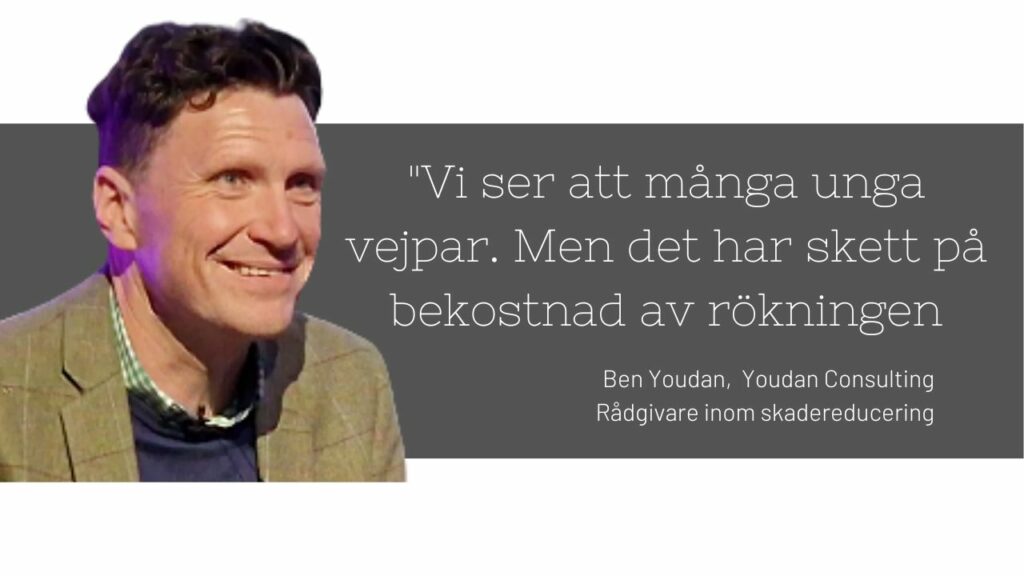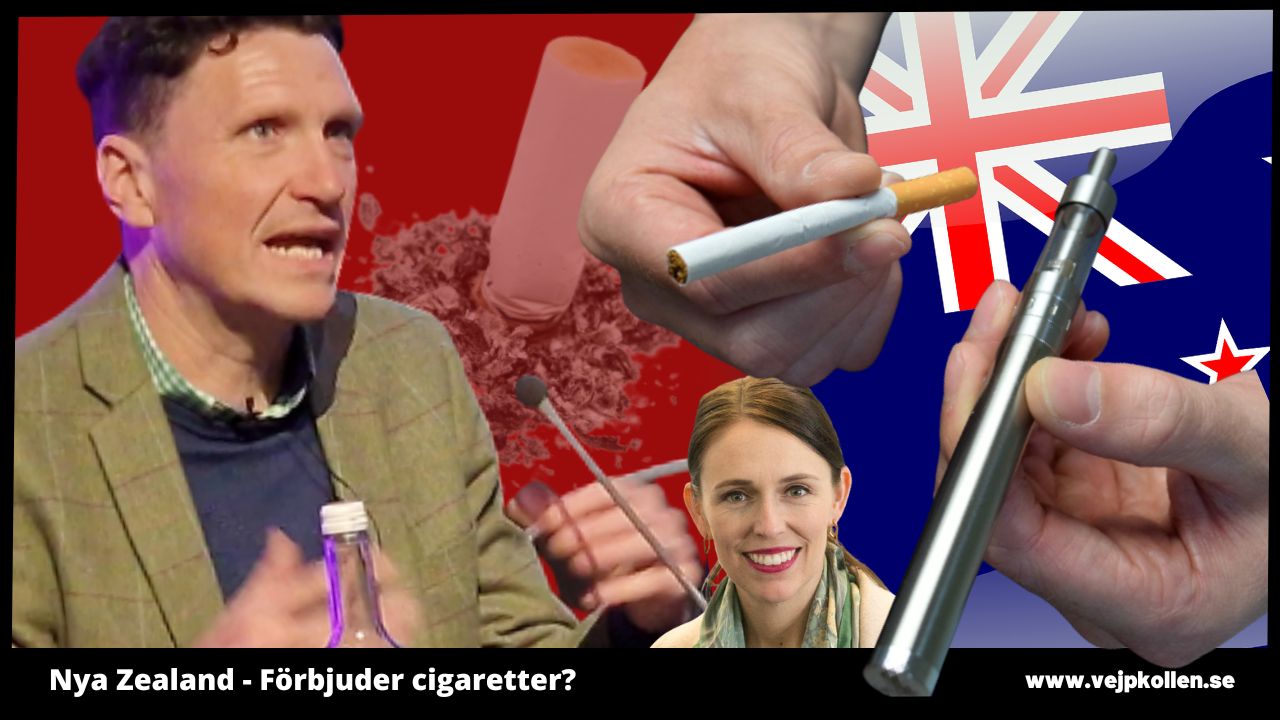Nya Zeelands kontroversiella politik för att minska rökningen, med förbud och cigaretter med låg nikotinhalt, väcker uppmärksamhet över hela världen. Men vad är det som händer egentligen? Vejpkollen gör en djupdykning i en strategi som har starka rötter i skademinimering – där e-cigaretter och vejpning spelar en central roll.
Vejpkollen bevakar E-cigarette summit London 2022
Reporter: Stefan Mathisson
Cigaretter med extremt låg nikotinhalt. Generationsförbud mot att köpa dem och endast ett fåtal butiker som får sälja röktobak. Som Vejpkollen tidigare rapporterat har Nya Zeelands radikala åtgärder för att minska rökningen fått uppmärksamhet över hela världen.
”Men det är väldigt viktigt att alla förstår bakgrunden. Den handlar om skadereducering och en medveten strategi för att främja e-cigaretter, produkter med en relativt lägre skaderisk jämfört med cigaretter. Utan detta hade ingen vågat tänka tanken på att i praktiken förbjuda cigaretter” säger Ben Youdan, politisk konsult och tidigare chef för Action on Smoking and Health i Nya Zeeland.
”Folket ville ha säkrare nikotin”
Grunderna för ett ”Tobacco Endgame” i Nya Zeeland i lades egentligen för 12 år sedan. 2010 satte en parlamentarisk utredning ett datum för ”ett rökfritt Nya Zeeland” 2025. Målet var att minska andelen rökare i befolkningen till under fem procent.
”Men utredningen konstaterade samtidigt att många Nya Zealändare ville få tillgång till fler och säkrare sätt att bruka nikotin. Det tog man fasta på. Skademinimering har sedan dess varit en viktig del av den Nya Zeeländska strategin mot rökning ” säger Ben Youdan, när han presenterar den Nya Zeeländska strategin vid E-cigarette summit 2022 i London.
Låg riskprofil
E-cigaretter och svenskt snus var några exempel som utredningen lyfte fram som viktiga verktyg i strategin. Då var e-cigaretter en förhållandevis okänd produkt.
”Men lokala forskare övertygade beslutsfattarna om dess relativa låga riskprofil jämfört med rökning. Dessutom bedömde man att de absoluta riskerna sannolikt var låga” säger Ben Youdan.
Reglering av e-cigaretter
Under de kommande 10 åren sjösattes det som kom att bli en av världens hårdaste lagstiftningar för cigaretter. I takt med att landet höjde skatterna på röktobak kraftigt, begränsade marknadsföring och reglerade förpackningarnas utseende, lät man samtidigt e-cigaretter ta plats vid sidan av cigaretterna, utan någon omfattande reglering.
När myndigheterna sedemera mätte användandet av e-cigaretter 2018 visade det sig att strategin hade fått effekt. Och det med råge, konstaterar Ben Youdan.
”Vi såg en stadig nedgång av andelen rökare över hela befolkningen. Samtidigt såg vi att vejpningen ökade snabb takt, sedan produkterna fått fäste på marknaden. Jag har jobbat inom tobakskontroll i över 20 år och trodde inte mina ögon när jag såg det. Det var uppenbart att det fanns en koppling mellan åtgärderna och övergången till vejpning, även om vi inte kunde bevisa ett tydligt kausalt samband. Vi såg det i synnerhet bland unga och bland ursprungsbefolkningen Mauri, grupper som länge haft stora andelar rökare” säger Ben Youdan.
Hårdare regler sedan 2021
Sedan 2021 har Nya Zealand byggt ett regelverk även kring e-cigaretter. Detta innbär att e-cigaretter omfattas av en 18-årsgräns, kräver registrering och systematisk återkoppling om hälsoeffekter till hälsomyndigheterna. Inte helt olikt systemet inom EU, Storbritannien och Sverige. Men det innebar även begränsning av smaktillsatser samt att e-cigaretter inte fick säljas var eller hur som helst.
”Det är exempelvis inte tillåtet för vanliga butiker att sälja annat än slutna system med en nikotinhalt på max 20mg/ml. De får dessutom bara vara smaksatta med tobak- och mentholsmaker. Specialistbutiker, de som har sin huvudsakliga inkomst från vejpprodukter, får däremot sälja alla smaksättningar och apparater samt lite högre nikotinhalter. berättar Ben Youdan.
Stort upptag bland unga
Samtidigt satsade myndigheterna på omfattande sluta-röka-kampanjer och finansierade hemsidor som upplyste om e-cigaretter som skademinimering samt som ett effektivt verktyg för att fimpa.
”Överlag regleras e-cigaretter hårdare än cigaretter idag. Trots detta ser vi ett stort upptag bland unga. Men det har skett på bekostnad av rökningen. Idag röker mindre än 1 procent av ungdomarna dagligen. Runt 10 procent vejpar. ” Konstaterar Ben Youdan.
Cigaretter med låg nikotinhalt
Den 12 december 2022 tog Nya Zeeland nästa steg för att minska rökningen i landet. Ett beslut om att tvinga ner nikotinhalterna i cigaretter till extremt låga nivåer, samt ett förbud att sälja cigaretter till de som är födda efter 2008 klubbades i december 2022. Åtgärden har fått stort genomslag i medierna runt om i världen. Men Ben Youdan är inte säker på att den nya lagstiftningen är rätt väg att gå.
”Om vi tittar närmare på den utveckling vi har sett de senaste åren så blir det uppenbart att vi redan är på rätt väg, om vi bara fortsätter att göra det vi gör. Rökningen kommer att ligga på under fem procent 2025. Bland ungdomarna röker 1 procent dagligen, medan 10 procent vejpar. Vi har redan nu en rökfri generation och förklaringen till detta ligger i en tydlig strategi där e-cigaretter, det vill säga skademinimering, har fått en central roll” säger Ben Youdan.

Betonar onödiga risker
Att avnikotinisera cigaretter och införa ett kontroverisellt förbud är därför inte nödvändigt för att minska rökningen, menar Ben Youdan. Han beskriver det mer som en principiell fråga, kantad av politisk prestige.
”Resultatet blir en åtgärd som kan få oanade konsekvenser, inte minst för de äldre, som fortfarande vill röka. Det blir en tvångsåtgärd, som egentligen inte behövs” säger han.
Ben Youdan betonar även riskerna för en svart marknad, som kommer att växa så länge det finns en efrerfrågan på ”vanliga” cigaretter.
Skademinimeringen är central
Men det är framför allt bristen på kommunikation om strategin som helhet som oroar Ben Youdan. Han saknar helhetsynen, i synnerhet när nyheten om ”cigarettförbud i Nya Zeeland” sprids över världen.
”Jag tycker att vi ska vara väldigt öppna när vi pratar om orsakerna bakom Nya Zeelands framgångar när det gäller rökningen. Vi måste lyfta fram de verkliga orsakerna. Det vill säga hård lagstiftning kring cigaretter i kombination med skademinimering. Det är det som möjliggjort de här åtgärderna. Annars är risken stor att andra länder tar efter, utan att de förstår bakgrunden och då kan det gå riktigt illa” säger Ben Youdan.
Förbudet omöjligt utan alternativ
Även Nya Zeelands premiärminister Jacinda Arden har tydligt sagt att vejpning och e-cigaretter är grunden för beslutet att införa den nya åldersbegränsingen, samt kravet på lågnikotincigaretter.
”Vi har sett att rökare numera har ett fullgott alternativ för att bruka nikotin. Det är den utvecklingen som gör att vi nu vågar ta nästa steg i att fasa ut cigaretterna från marknaden” sade Jacinda Arden i ett uttalande 2021, när regeringen lade fram förslaget som nu blivit lag.
”Politiker i världen missar poängen”
Men trots att premiärministern varit tydlig, är det enligt Ben Youdan alldeles för lätt att medier och politiker helt enkelt missar ett viktigt budskap . Den förenklade versionen är mer lättsmält, i synnerhet som det råder delade meningar om vilken roll skademinimering har fått kampen mot rökningen.
”Jag läste nyligen en artikel om vår nya lag i en Australiensisk tidning. Där nämndes varken skademinimering eller e-cigaretter en enda gång. Det handlade bara om hårda tag, låga nikotinhalter i cigaretterna och den annorlunda åldersbegränsningen. Risken är stor att politiker i andra länder missar poängen och frestas att införa lagstiftning som sannolikt inte fungerar” konstaterar Ben Youdan.




